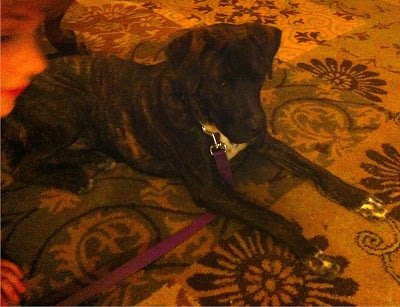A friend of mine has asked for help finding a new home for this sweet guy.His name is Chauncey, but it has been changed to Norris by the family he is with. I think you could name him whatever and he would answer to anything.
He just desperately wants someone to love him!I rescued him from the Dallas SPCA and they told me he was a Hound/Pit mix, but I think he looks a little like a black lab is in there somewhere.
He is mostly black, with a little white on him and a brindle coloring on his back.
He is extremely playful, still has some puppy behavior in him, very energetic, and he needs a lot of attention.
He is not for someone that just wants to put him out in the backyard to watch the house. I can tell that he was an indoor dog before I got him, but has been an outdoor dog for the last 6 months. I would like to find him a home where he can be indoors at least half the time because he is house trained and he is extremely social.
He is very loyal to whomever he knows that loves him.
I have never seen such a dog that shows his emotions on his little face so openly.
I went to the SPCA back in the winter earlier this year and he had the saddest face and looked so adorable that I had to save his life. I considered keeping him myself, but my dog was so territorial that they wanted to kill each other. So then I placed him in a home with 2 boys and it seemed like a match made in heaven, but they never built a fence for him and the poor guy has been starved for attention and living outside. I am afraid it wasn't a good match.
I think Chauncey really just wants to be a human. He is sweet with kids and adults that he knows, but there was one instance where he lunged at a man that he did not know that was visiting his owners. He is a watch dog and needs a good secure fence (if he is to be outside) but he is house trained and loves being indoors the most.
He is fixed and micro-chipped and has been given all of his shots.
I paid $95 for him at the SPCA. He is really a gorgeous dog!
He is in Hillsboro, Texas right now but I can get him up to the DFW area easily if you are located there. I had him checked up at the Animal Hospital in DeSoto earlier this year and they have him on record. I also have his papers from the SPCA and you can switch over the information on his microchip to your address. He tested in perfect health with no worms when I placed him, but I don't think his current owners have been giving him heart worm medicine like they should, so he might need to be tested for that before you put him on medicine.
He is around 2 years old, maybe younger.
I love him and because my first attempt in placing him didn't work out so well, I am really going to stress that he is a dog that is really in need of attention.
I don't want to have to place him again, but I will always take him back because I NEVER want that sweetie to see the inside of a shelter again! He is a very sensitive soul and he was so freaked out in the pound. You should have seen the sad look on his face. He is a very loving creature and he really loves to sleep in your bed and sit on you, if he could get away with it.
Whomever adopts him will find a loyal buddy for life. He has SO much love and he needs the right person or family to share his love with. If you think you might be that person, then please contact me at
lphiddleston@aol.com and type "Chauncey" on the subject line so that I see it right away. Thanks for your time in reading this and feel free to share with others.
Chauncey was current on all of his shots as of February 2011 when I took him to the DeSoto Animal Hospital in DeSoto, TX and they gave him a check-up. I adopted him in January and the Dallas SPCA had him completely evaluated and he is healthy.
He is micro-chipped and neutered.
He is house-broken.
Please contact me by email at lphiddleston@aol.com or on my mobile phone at 214-325-8028.













